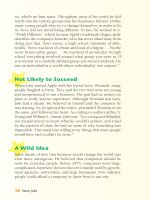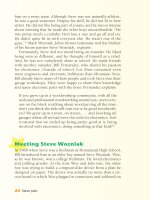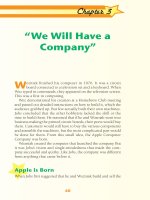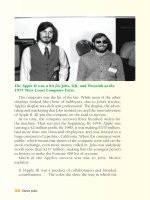Steve Jobs.Other books in the People in the News series phần 8 pptx
Bạn đang xem bản rút gọn của tài liệu. Xem và tải ngay bản đầy đủ của tài liệu tại đây (1.25 MB, 10 trang )
70
Steve Jobs
Jobs knew he had to take some radical steps to save Apple.
One of the first things he did was make a deal with Microsoft. In
exchange for $150 million, all Macintosh computers would use
Microsoft’s Explorer web browser and its Office software. Jobs
announced the deal in August 1997 in front of a large audience
of Apple devotees at the annual MacWorld Conference and Expo
in Boston. This audience booed the announcement.
In the past, Jobs had accused Microsoft of stealing the idea
for Windows from Macintosh. Many Apple devotees looked at
Microsoft as the enemy, and they felt betrayed by Jobs. But Jobs
knew that this was the best way to help Apple financially, and he
was right. The value of the company’s stock rose 33 percent as a
result of his action.
He is Back
With enough money to keep the company afloat, Jobs turned his
attention to Apple’s employees and products. He seemed to be
everywhere. He spent hours walking around the Apple campus,
questioning whomever he met about who they were and what
Apple lost over $1 billion under Gil Amelio, right, and Jobs
returned to Apple as interim CEO.
Into the Future
71
they did. He also held meetings with different groups of employees
where he grilled them about the products they were working on. It
was up to each employee to convince Jobs that their product had
value. On a few occasions, his blunt manner and probing questions
reduced employees to tears.
Through these exchanges, Steve identified those people with
innovative ideas, and those he considered dead weight, firing the
latter. “Steve tests you, challenges you, frightens you,” explains
Todd Rulon-Miller who worked for Apple. “He uses this tactic to
get to the truth . . . It’s his way of asking: ’Do you believe in what
you’re saying?’ If you wither or blather, you’re lost.”
53
Once Jobs was satisfied with Apple’s staff, he worked directly
with the hundreds of employees who were not fired. Nothing was
done without his knowledge. Not even a paper clip was purchased
without his okay. Jobs had taken over.
Think Different
The next change he made involved advertising. Apple had lost its
image as a hip, renegade, cutting-edge company. That image, which
was in many ways a reflection of Jobs, helped distinguish Apple
from other more traditional computer companies. Many Apple
customers thought of themselves as rebels. When the company’s
outsider image faded, so did this customer base.
Jobs hired an advertising company to resurrect Apple’s image.
With Jobs’s input the company came up with the slogan “Think
Different,” which was scrawled atop pictures of innovative thinkers
like Albert Einstein, John Lennon, and Mahatma Gandhi, to name
a few. It was created not only to improve Apple’s sales, but also to
remind Apple employees what the company had been, and what it
could be again. “When I got back here, Apple had forgotten who
we were,” Jobs explains.
Remember that “Think Different,” ad campaign we ran? It
was certainly for customers to some degree, but it was even
more for Apple itself. You can tell a lot about a person by
who his or her heroes are. That ad was to remind us of who
72
Steve Jobs
our heroes are and who we are. We forgot that for a while.
Companies sometimes forget who they are. Sometimes they
remember again, and sometimes they don’t.
54
The iMac
Jobs’s changes were working. Five months after he took over
the company, it was turning a profit. With Apple heading in the
right direction, he turned his attention to the iMac, short for the
Internet Macintosh. It was a new computer, which Steve envi-
sioned as an inexpensive, easy to set up and use machine that
allowed users to easily access the Internet.
Keeping with the “Think Different” slogan, Jobs wanted the
iMac to look different from other computers. The computer,
Jobs’s innovative marketing campaign featured John
Lennon and Yoko Ono next to Apple’s "Think Different"
slogan.
Into the Future
73
monitor, and speakers were all contained in a clear oval shaped
case with fruit colored trim. It also had a keyboard that lit up
when it was touched. The machine, which debuted in 1998, was
an immediate success. By the close of the year more than 800,000
were sold. Many of the buyers were first time computer owners
who were taken by the machine’s stylish design and the ease with
which it fit into their home. Others were former Apple devotees,
flocking back to the quirky company they once adored.
Fun Facts
A
lthough Steve Jobs is not forthcoming about his personal
life, an article on the Apple Museum website gives some
fun facts about him. Here are a few:
His home: A red brick home built in the 1930s.
His heroes: David Packard, cofounder of Hewlett Packard;
Bob Noyce, cofounder of Intel; and singer Bob Dylan.
His close friends: Former California governor Jerry Brown;
Lawrence J. Ellison, billionaire businessman; and his sister
Mona Simpson.
Favorite clothes: Jeans, black turtleneck shirts, and run-
ning shoes.
His car: A Mercedes-Benz.
Connections to famous people: He dated singer Joan
Baez; he hosted former president Bill Clinton and Hillary
Clinton at his home in Palo Alto and spent the night in
the Lincoln Bedroom in the White House.
Most Prestigious Award: National Technology Medal with
Steve Wozniak from President Reagan in 1985.
Information taken from />74
Steve Jobs
Taking advantage of the machine’s success, Jobs insisted Apple
come out with a laptop version of the machine called the iBook a
year later. It became the best selling laptop computer of its time.
As a result, Apple’s stock rose to record highs.
The bright colors on iMacs set Apple computers apart from
other competitors.
Into the Future
75
iTunes, iPod, and a Music
Revolution
Jobs’s next step was even more radical. Taking Apple’s “Think
Different” campaign to heart, he decided to take the company in
a completely new direction. It would change the music industry
forever.
Jobs always loved music. When he and Wozniak first met their
love of Bob Dylan’s and the Beatles’ music helped bond them
together. Jobs imagined consumers using their computers as a
digital jukebox. There was already software available that could
play digital sound files on a computer. But it was complicated to
use. Jobs bought the rights to this software and had Apple engi-
neers simplify it so that Apple owners could easily copy songs
from compact discs (CDs) onto their computers. Jobs named this
program iTunes.
Now that Apple users could store their favorite songs on their
Jobs introduces Apple’s iTunes and iPod, allowing people to
buy and manage their own music library.
76
Steve Jobs
computer, Jobs turned his attention to coming up with a portable
device that individuals could transfer their music onto and take
with them everywhere. The device was named the iPod.
Similar devices known as MP3 players were already available,
but they were clumsy, unattractive, difficult to use, and did not
hold many songs. As a music lover, Jobs craved a better way to
listen to music; so did many members of his Apple team. So Jobs
decided to create it.
With that in mind, Jobs insisted that the iPod have excellent
sound, be so simple to use that listeners could access any song
they wanted in less than three pushes of a button, and be capable
of holding one thousand songs. In addition, he insisted the device
be small and stylish. While it was in development he constantly
checked and rechecked the device for design, sound, and ease
of use. He was not satisfied until it fit his specifications. “We did
iTunes because we all love music. We made what we thought was
the best jukebox in iTunes,” he explains. “Then we all wanted to
carry our whole music libraries around with us. The team worked
really hard and the reason that they worked so hard is because
we all wanted one. You know? The first few hundred customers
were us.”
55
The iPod was released in October 2001. It turned out to be
Apple’s best selling product yet. It also changed the way people
listened to music forever. But Jobs was not finished yet. At the
time, many people were downloading music and trading music
files via the Internet, without paying for them. Such action was
not simple, was illegal, and hurt the music industry. Jobs got the
idea of setting up an online music store, known as the iTunes
Music Store, which would allow consumers to download their
favorite songs for ninety-nine cents per tune. It would be inex-
pensive, legal, simple to do, and give music lovers access to thou-
sands of songs, including new releases.
Jobs was sure that his idea was the way music would be dis-
tributed and sold in the future. He explains:
When we created the iTunes Music Store, we did that
because we thought it would be great to be able to buy
music electronically . . . I mean, it just seemed like the writ-
Into the Future
77
ing on the wall, that eventually all music would be distrib-
uted electronically. That seemed obvious because why have
the cost? The music industry has huge returns. Why have
all this overhead when you can just send electrons around
easily?
56
At first, the recording industry, which was used to distributing
and selling music in the traditional way, did not agree with him.
But Jobs never had a problem bending others to his will. His
persuasiveness and clarity of vision convinced music industry
executives and artists that it was a good idea. The iTunes Music
Store opened in April 2003. In its first day, 275,000 songs were
downloaded. A year later, more than 85 million songs had been
Apple Retail Stores
A
pple retail stores are another of Jobs’s successful creations.
The stores sell everything Apple makes, giving consumers
a convenient place to learn about and try Apple’s products.
The first store opened in Virginia in 2001. As of 2009, there
are 251 stores located throughout the world. The stores are
all stylishly designed. Many have won architectural awards. All
contain a Genius Bar, where customers can ask questions, get
technical support, and have products repaired.
Newer stores have a studio where customers can get help
in all sorts of creative ventures. The stores offer free group
workshops and one-on-one personal training. There are also
special programs for children, including Apple Summer Camp
where kids can take free classes in digital photography, movie
making, and other topics.
The stores are extremely popular. New store openings have
become big events drawing crowds of people who often line
up outside the store the night before. Usually the first one
thousand customers are given free gifts such as commemora-
tive tee shirts and goodie bags.
78
Steve Jobs
downloaded. By 2008 it had become the largest retailer of music
in the United States. Moreover, it permanently changed the way
music is sold and distributed. Once again Jobs’s vision of the
future seemed to be just what the public wanted.
Facing Death
It looked like Jobs’s life could not get any better. He had a won-
derful family who he adored. Pixar was doing well. And, he had
turned things around at Apple. In 2000, he had finally agreed to
become the CEO of Apple, accepting ten million shares of the
company’s stock, which was worth over $800 million.
Then in 2004, his seemingly perfect life came crashing down.
Jobs was diagnosed with pancreatic cancer, a disease from which
90 percent of patients die within a year. At the time, the doctor
told Jobs that the disease was incurable and usually carried a life
expectancy of less than one year. But later in that day, the doctor
performed a procedure, which involved retrieving a sample of
cancer cells, in order to study the cancerous tumor more care-
fully. Jobs had an extremely rare slow-growing form of pancreatic
cancer that, in some cases, surgery can cure. At first, Jobs resisted
having surgery, believing he could cure the disease by eating a
special diet. When that did not work, he had the surgery, which
left him cancer free.
Jobs recalls what happened:
I had a scan at 7:30 in the morning, and it clearly showed a
tumor on my pancreas. I didn’t even know what a pancreas
was. The doctors told me this was almost certainly a type of
cancer that is incurable and that I should expect to live no
longer than three to six months. My doctor advised me to go
home and get my affairs in order, which is doctor’s code for
prepare to die. . . . I lived with that diagnosis all day. Later
that evening, I had a biopsy, where they stuck an endoscope
down my throat, through my stomach and into my intes-
tines, put a needle into my pancreas and got a few cells from
the tumor. . . . it turned out to be a rare form of pancreatic
Into the Future
79
cancer that is curable with surgery. I had the surgery and I’m
fine now. This was the closest I’ve been to facing death and
I hope it’s the closest I get for a few more decades.
57
Jobs’s brush with death caused him to look at the direction his
life was taking. It was not too late to make changes. But he found
he did not need to. He was happy with his life. “One thing that
came out most clearly from this whole experience,” he explains. “I
realized that I love my life. I really do. I’ve got the greatest family
in the world and I’ve got my work. And that’s pretty much all I
do. I don’t socialize much or go to conferences. I love my family,
and I love running Apple and I love Pixar. And I get to do that.
I’m very lucky.”
58
Moving Forward
Jobs did not let his coworkers know about his illness until after
his surgery. A month later, he returned to Apple part-time. Soon,
he was back full strength. Under his guidance, Apple continued
In 2004 Jobs was diagnosed with pancreatic cancer and
addressed his illness publicly.









